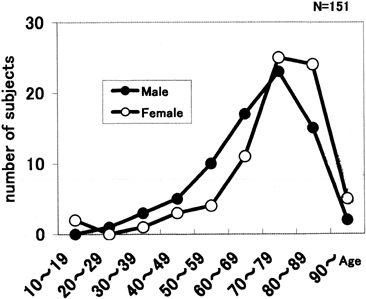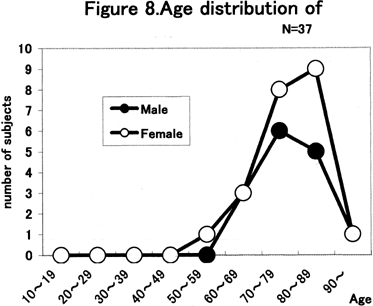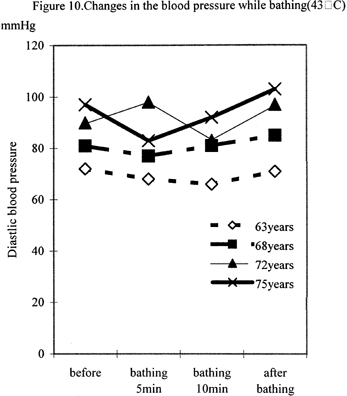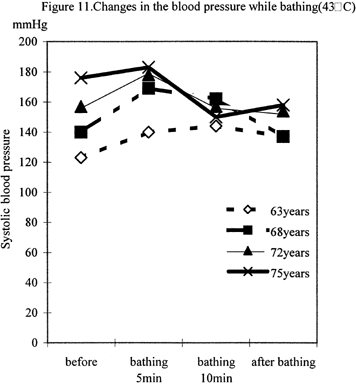During a 2-year period between 1996 and 1997, 3,038 cases were examined through medico-legal investigations and autopsies at university forensic departments. Among them, 303 who succumbed while soaking in the tub, in washing areas outside the tub, or in the dressing rooms, were investigated.
The causes of death while bathing for men were: 66 from cardiovascular diseases; 6 from cerebrovascular diseases; 6 from respiratory diseases, and 3 from digestive system diseases. Among women, 51 suffered from cardiovascular diseases, 11 from cerebrovascular diseases, and 3 from digestive system diseases. The mortality from cardiovascular diseases was the highest across genders (total of 117 cases). Drowning incidents occurred in 151 while bathing in the tub (77 males and 74 females), mostly during the winter season. Causes attributable to fatal drowning were transient ischemic attacks and bathing after drinking alcohol. For some there were no obvious causes detectable at autopsy that led to drowning while bathing. The occurrence of death while bathing is high among those over 65 and clusters around the frigid season (between December and March). In more than one-half of them, the cause of death was a cardiovascular or cerebrovascular disorder.
Introduction
By stimulating peripheral circulation, in addition to cleaning the body, taking a bath activates the body's metabolism and gives the bather a refreshed feeling. The bath is one of the customs in the daily lives of Japanese that they cannot do without. In recent years, however, there has been a rapid rise in bathing death accidents that has ranged from middle-aged people in the prime of their lives to the elderly, and it has become a major social problem. It has been projected that in the next several years the annual number of fatal accidents while bathing will exceed 10,000, a trend that will surpass traffic accidents as a cause of death in Japan. For Westerners taking a bath is a matter of cleaning the body, with most people taking showers and giving little thought to heating the body by taking a warm bath. In the West the bathtub is a place to wash the body, and Western tubs are shallow. The depth of the Japanese-style bathtub has a considerable impact on changes in circulatory dynamics, and this is thought to be associated with accidents while bathing.
Subjects and Methods
The subject of this study was the 303 cases (10%) of sudden death while taking a bath, in the washing area, in the dressing room, etc., among the 3,038 cases of in which a postmortem examination was performed in the Legal Medicine Department of Yokohama City University School of Medicine in 1996 and 1997, and a medicosocial assessment of these cases was conducted in regard to frequency of occurrence by month of year, cause of death, temperature of the bath water, etc.
Results
The bathing deaths consisted of 147 cases of sudden death (48.5%), 151 cases of accidental death (49.8%), 4 cases of suicide (1.32%), and 1 unknown (0.3%), and there was hardly any difference between the numbers of sudden deaths and accidental deaths. According to gender, there were 161 male cases (53.1%) and 142 female cases (46.8%), and thus bathing deaths were slightly more common in males. Examination of the deaths according to month of the year revealed that they were more common in the cold period extending from November to April, that is, from winter to early spring, and they were particularly frequent in the winter months of December and January. As it grew warmer from April onward, the number of deaths decreased, with the lowest number of deaths, 10, in August, whereas the highest number, 52, occurred in January. With 68.3% of all bathing deaths occurring during the 6-month period from November to April, they were most frequent during the cold season (Figure 1).
?C????????
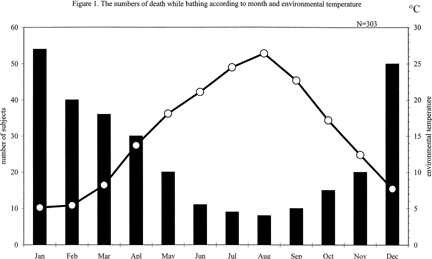
Figure 1. The numbers of death while bathing according to month and environmental temperature.
Time of occurrence during the day
Examination of the numbers of deaths according to the hour of the day when they occurred revealed that the greatest number of deaths occurred during the 3-hour period from 19:00 to 22:00, and from the early evening onward has also always been the most common time for people to take their baths (Figure 2).
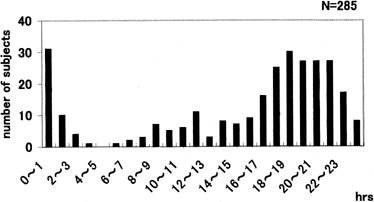
Figure 2. Time of occurrence during the day.
Site of death
The site of the bathing deaths was almost in the person's own home in 291 (96%) of the 303 cases, and outside the home in the other 12 cases (3.96%). More specifically, the site of the deaths within the home was inside the bathtub in 263 cases (86.7%), outside the bathtub (in the washing area) in 39 cases (12.8%), and in the dressing room in 1 case (0.3%).
Causes of death outside the bathtub
When the deaths that occurred outside the bathtub were reviewed according to cause of death and gender, there were 39 deaths outside the bathtub (in the washing area). The cause of death was myocardial infarction in 9 of them (23.1%), acute heart failure in 7 (17.9%), heart failure in 6 (15.4%), congestive heart failure in 1 (0.6%), cardiac tamponade secondary to rupture of a myocardial infarction in 3 (7.7%), subarachnoid hemorrhage in 4 (10.3%), cerebral hemorrhage in 3 (7.7%), and other causes in 6. The most common cause of deaths outside the bathtub, the same as deaths inside the bathtub, was cardiovascular disease, especially ischemic heart disease, and it accounted for 8 (27.5%) of the 29 cases in males. Cerebrovascular disease accounted for 3 cases. Cardiac tamponade was observed in 3 of the cases, and was a special feature of deaths outside the bathtub.
Temperature of the bath water at the time the death was discovered
Bath water temperatures of 40? and below are usually considered "tepid" (moderate-temperature bath), and temperatures of 44? and above are considered "hot" (high-temperature bath), with intermediate temperatures of 41-43? being said to the proper temperature. Among the total of 303 cases, assessment of the 126 cases (42%) in which the temperature of the bath water was known for certain showed a marked increase in deaths when the boundary was set at 41?. More specifically, 96 (76%) of the 126 deaths occurred at 42? or more, whereas only 30 (24%) occurred at 41? or below, and thus the most suitable bath water temperature appears to be 41? or less. The peak number of deaths in the bathtub occurred at a bath water temperature of 43? (Figure 3).
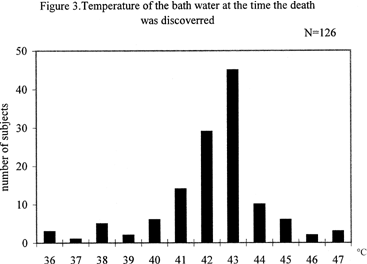
Figure 3. Temperature of the bath water at the time the death was discoverred.
Cause of death
Division of the causes of death in the 303 cases into endogenous causes (sudden death while taking a bath, death due to disease, etc., while taking a bath, etc.) and exogenous causes (accidental death while taking a bath, drowning deaths, alcoholic intoxication, etc.) revealed 147 sudden deaths while taking a bath, with 82 (55.7%) of them occurring in men and 65 (44.2%) in women (Figure 4). Assessment according to gender and age showed a clear increase beginning in the 50s in males, with those occurring at 60 years of age and over accounting for 78%, whereas among the females there was a marked increase beginning in the 60s, and those in their 70s accounted for 78% (Figure 5).
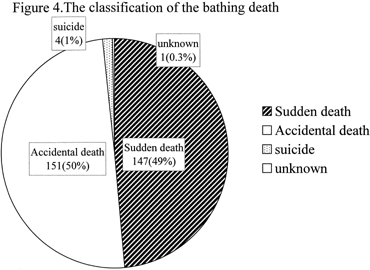
Figure 4. The classification of the bathing death.
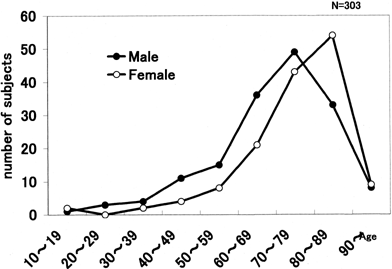
Figure 5. Destribution of gender and age.
The causes of death in the males consisted of cardiovascular diseases (most commonly ischemic heart disease) in 59 (44.8%), cerebrovascular diseases (most commonly cerebral hemorrhage and subarachnoid hemorrhage) in 6 cases (4.08%), gastrointestinal diseases in 3 cases (2.04%), respiratory diseases in 6 cases (4.08%), and others in 1 cases (0.68%), with ischemic heart disease accounting for 40.1%, while among the females the causes of death were cardiovascular diseases in 51 (34.7%), cerebrovascular diseases in 11 (7.48%), and gastrointestinal diseases in 3 cases (2.04%), with ischemic heart disease accounting for 34.6%. Among the women, deaths in the 70-80s bracket accounted for 74.5% of the total. There were 6 cases of cerebrovascular disorders in the males and 11 in the females, and those 60 years of age and over accounted for 14 of them (9.52%) (Table 1).
Table 1. Cause of death while bathing
Disease |
Male |
Female |
Total (%) |
cardiovascular diseases |
66?? |
51 |
117(38.6) |
ischemic heart disease |
59?? |
50 |
109(36.0) |
cardiac tamponade |
3 |
?0 |
3(1.0) |
rupture of aortic aneurysm |
1 |
?0 |
1(0.3) |
other heart disease |
3 |
?1 |
4(1.3) |
crebrovascular disease |
6 |
11 |
17(5.6) |
cerebral hemorrhage |
4 |
6 |
10(3.3) |
subarachnoid hemorrhage |
2 |
5 |
7(2.3) |
gastrointestinal disease |
3 |
3 |
6(2.0) |
respiratory disease |
6 |
??0 |
6(2.0) |
others |
1 |
??0 |
1(0.3) |
drowning |
77?? |
74 |
151(49.8) |
suicide |
1 |
??3 |
4(1.3) |
unknown |
1 |
??0 |
1(0.3) |
total |
161??? |
142 |
303(100.0) |
Accidental deaths while taking a bath
Of the 151 accidental deaths (49.8%) while taking a bath, 77 (50.9%) were in males and 74 (49%) in females, and their occurrence was concentrated in the cold period, the same as the sudden deaths (Figure 6). Examination of the cases according to gender and age revealed that a marked increase in the 50s in the males, with the cases in the 50s to 80s accounting for 85.7% of the cases in the males. A marked increase began in the females in their 60s, and similar to the males, those in their 60s to 80s accounted for 81% of the cases (Figure 7). As a cause of death among the accidental deaths drowning deaths secondary to a transient ischemic attack (TIA) occurred in a total of 37 cases (24.5%), 15 males (9.9%) and 22 females (14.56%) (Figure 8). There were 69 cases (45.6%) of drowning deaths due to exogenous causes, 44 in males (29.1%) and 25 in females (16.5%). The autopsies in the endogenous death cases did not reveal any other findings that would have resulted in death, only the findings observed in drownings, and among the 45 cases (29.8%) of drowning death in which the cause of death was unknown there were 18 males (11.9%) and 27 females (17.8%), and their age distribution revealed 11 males (61%) and 22 females (81.4%) in their 60s to 80s (Figure 9).
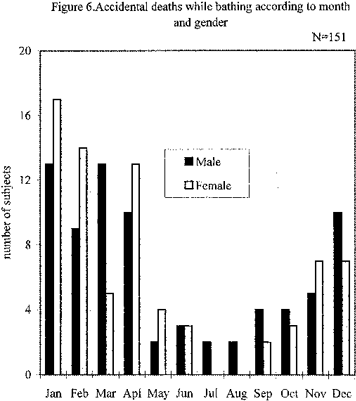
Figure 6. Accidental deaths while bathing according to month and gender.
|
|
Figure 7. Age distributin of drowning death while bathing |
Figure 8. Age distribution of drowning by TIA. |
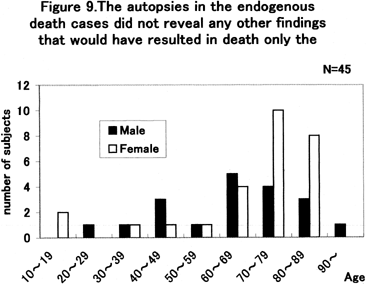
Figure 9. The autopsies in the endogenous death cases did not reval any other findings that would have resulted in death only the findings observed in drownings.
The blood pressure of 4 elderly persons was measured before entering the bath, 5 and 10 minutes after entering the bath, and after leaving the bath. After entering the bath their systolic pressure first rose, and either it subsequently fell or the tendency was as severe as in hypertension patients. The changes in diastolic pressure were not as intense as the changes in systolic pressure (Figure 10,11).
|
|
Figure 10. Changes in the blood pressure while bathing (43?C). |
Figure 11. Changes in the blood pressure while bathing (43?C). |
The changes in blood pressure appeared to be especially dramatic when patients with a history of hypertension took baths when the atmospheric temperature was low, and these dramatic fluctuations in blood pressure are thought to have contributed to the drowning deaths while taking a bath in those with cardiovascular diseases, particularly ischemic heart disease (myocardial infarction, coronary arteriosclerosis, etc.), and cerebrovascular disease (cerebral hemorrhage, subarachnoid hemorrhage, etc). Marked increases and decreases in systolic pressure as a result of taking a bath were also observed in measurements of blood pressure fluctuations in 4 elderly patients in this study, and the decrease in blood pressure may have caused transient cerebral ischemia as a result of the low blood pressure. Thus, if loss of consciousness occurred secondary to transient cerebral ischemia as a result of a drop in blood pressure, patients may have died of drowning due to this loss of consciousness. At autopsy, severe cerebral arteriosclerosis was found in the 37 cases of drowning as a result of a so-called TIA (transient ischemic attack), and there appeared to be a strong possibility that a TIA contributed to it. Even such a transient onset of symptoms, if it occurs while taking a bath, could lead to a drowning death with the attack as its cause.
In addition, when a relatively healthy elderly persons drown to death while taking a bath, one would expect some cause of the deaths to be peculiar to the bathing itself, but based on the results of our survey they appear to have been attributable to transient consciousness disturbances associated with alcohol consumption, decreases in blood pressure (especially in systolic blood pressure), cerebral arteriosclerosis, etc. The low air temperature in winter and hot both water (42? or higher) are probably major factors in blood pressure fluctuations.
Elderly persons have some degree of underlying diseases and taking a bath appears to act as a trigger that exacerbates a variety of diseases.
Discussion and Conclusions
Sudden deaths while taking a bath occur throughout the year, but they start to increase in November, peak in February, and persist at high levels until April, with this 6-month period accounting for 75% of all bathing deaths. Differences in temperature between the living room and inside the bathroom and between the outside the bathroom and inside the bathtub appear to be the reason for this. The cardiovascular system and the cerebrovascular system are involved in the majority of causes of death, and it has long been claimed that changes in the temperature environment predispose to heart attacks or cerebral infarcts. Drowning was the cause of death in the 151 accidental deaths while bathing. There were 37 drowning deaths (15 males, 22 females) that seemed to be due to TIAs, which are often observed in elderly persons in their 60s to 80s. Ability to recover, adaptability, and resistance are lower in these age brackets, the body is unable to adapt to changes in environmental temperature, and, especially when the temperature in the bathtub exceeds 40?, bathing is suspected of causing abrupt changes in blood pressure that induce ischemia in the cerebral blood vessels 1)-3).
No findings that would result in death were observed even at autopsy, with the only findings noted being those seen in drowning, and no factors that would predispose to death were detected, and the drowning deaths are inferred to be related to the temperature differences at the time of the bath and the hydrostatic pressure attributable to the depth of the bathtub and to have resulted from loss of consciousness secondary to cardiovascular failure due to fluctuations in blood pressure 4)5) and compression of various organs or from loss of consciousness caused by inebriation as a result or consuming alcoholic beverages 6). Among the accidental deaths, alcohol was detected in the blood in 38% of the drowning deaths due to loss of consciousness as a result of a state of inebriation caused by alcohol consumption, suggesting that it is risky to take a bath after consuming alcohol.
Persons with a history of hypertension or myocardial infarction must be especially careful about bathing during the season when atmospheric temperatures are low. It is important to make adjustments that minimize differences between the atmospheric temperature and the temperature in the bathtub, the temperature in the bathtub and the temperature in the dressing room, and the temperature in the dressing room and the temperature in the living room, and in addition to avoiding bathing after consuming alcohol, the families should be more attentive.
Conclusion
1. Bathing deaths are most common in the winter, when the atmospheric temperature is low.
2. Bathing deaths tend to occur when the bath water temperature is high: 42? or more.
3. Bathing deaths tend to occur when elderly persons with a history of hypertension, ischemic heart disease, or cerebral infarction take hot baths.
4. Bathing deaths tend to occur when a person takes a bath without other family members noticing.
5. Bathing deaths are most common among elderly persons 65 years of age and over.
6. Bathing deaths tend to occur when there are temperature differences between the dressing room and the bathroom, and in Japanese-style bathtubs, which are deep.
7. Bathing deaths tend to occur as a result of impairments of circulatory function, such as abrupt changes in blood pressure and sweating associated with the act of taking a bath.
References
Soejima K, Hori S, Fujishima S, Kimura H, Takeda H, Sasaki J, Shinozawa Y, Aikawa N, A cause of sudden death in Japanese bath tub neurally mediated syncope as a cause of sudden death, Journal of Japanese Association for Critical Care Medicine 1997; 11: 57-60
Tochihara Y, Bathing in Japan: A Review, Journal of the Human-Environment System 1999; 3.1: 27-34
Shirakura T, Hot spring and cerebral apoplexy, Science of Hot Spring 1999; 49: 1-7
Shintani F, Watanabe S, Inaki K, Tanaka S, Clinical implication of sequential changes in blood pressure and heart rate during Japanese-Style Bathing, Journal of Intensive Care Medicine 1982; 6.9: 759-765
Shirakura T, Cerebral apoplexy and hot spring, Health Care 1990; 32.5: 276-281
Inamura K, Sudden death of aged persons in bath tub, Res. Pract. Forens. Med. 1995; 38: 349-351
Список литературы
1.Soejima K, Hori S, Fujishima S, Kimura H, Takeda H, Sasaki J, Shinozawa Y, Aikawa N, A cause of sudden death in Japanese bath tub neurally mediated syncope as a cause of sudden death, Journal of Japanese Association for Critical Care Medicine 1997; 11: 57-60
2.Tochihara Y, Bathing in Japan: A Review, Journal of the Human-Environment System 1999; 3.1: 27-34
3.Shirakura T, Hot spring and cerebral apoplexy, Science of Hot Spring 1999; 49: 1-7
4.Shintani F, Watanabe S, Inaki K, Tanaka S, Clinical implication of sequential changes in blood pressure and heart rate during Japanese-Style Bathing, Journal of Intensive Care Medicine 1982; 6.9: 759-765
5.Shirakura T, Cerebral apoplexy and hot spring, Health Care 1990; 32.5: 276-281
6.Inamura K, Sudden death of aged persons in bath tub, Res. Pract. Forens. Med. 1995; 38: 349-351


 Федеральное государственное бюджетное учреждение науки
Федеральное государственное бюджетное учреждение науки

